Boh Loh Yao: Hong Kong’s Pineapple Bun
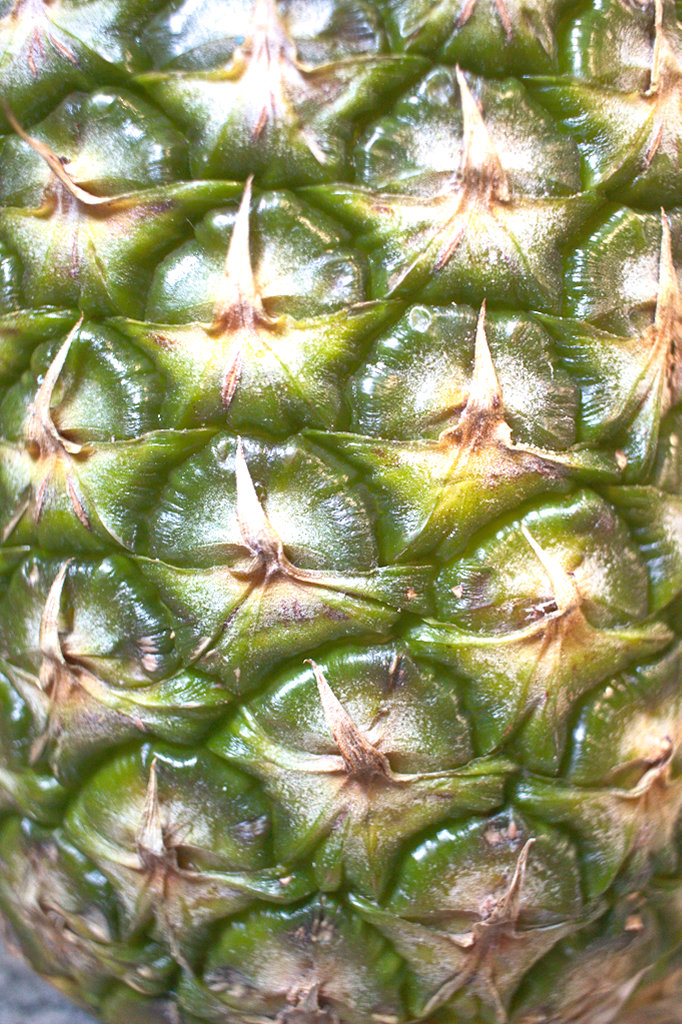
Pineapple buns, or bolo bao, are beloved mildly sweet treats in their native Hong Kong. Made from a soft white dough similar to that used in Japanese milk bread, but with a thin cookie coating that cracks as the main bun expands in the oven, they are similar to Japanese melonpan or Mexican concha. They do not contain any pineapple, but are named for the appearance the cracking outer pastry shell gives the roll, like the rough surface of a pineapple.
The technique of making these buns has been named by the Hong Kong government as part of their “intangible cultural heritage” to be safeguarded. The buns have even been enshrined in pop culture–or perhaps crowned is a better term–in the 2nd movie featuring a dim-witted anthropomorphic pig named McDull, in which the title character wears a pineapple bun hat. It all seems very confusing.
Clearly a trip to Chinatown would be in order, to revisit some bakeries that I visited with Damian 4 years ago when researching the ham and egg bun. On this occasion, however, near the beginning of June in 2020, I arrived by myself to find Chinatown had become a ghost town. I was able to easily find parking right on the main Chinatown strip on Wentworth, directly in front of one of the bakeries I came to visit. The streets were not quite empty, but not packed with people the way I usually experienced them. The Chinatown Square Mall was nearly abandoned. More than a few businesses were boarded up, awaiting better times before reopening.
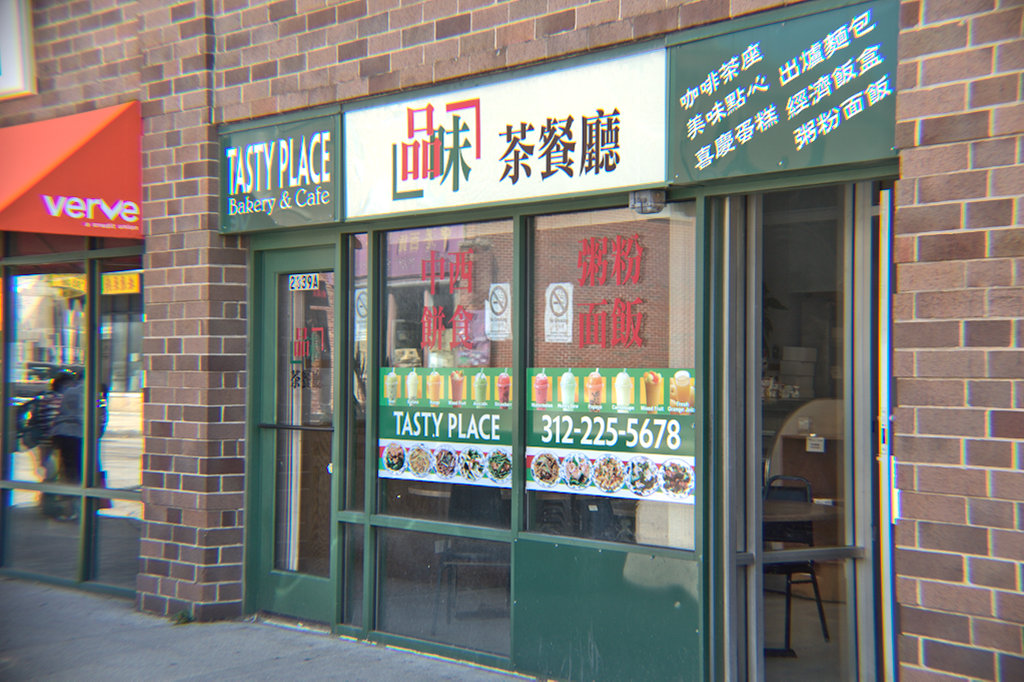
However, I was able to score a couple pineapple buns from Tasty Place. There are two businesses named Tasty Place, about a block apart and on opposite sides of Wentworth, and while I don’t know for sure that they’re related I believe them to be, as they have similar color schemes and offer similar products. This more southerly location located on the east side of the street appears to be the more lightly trafficked of the two.
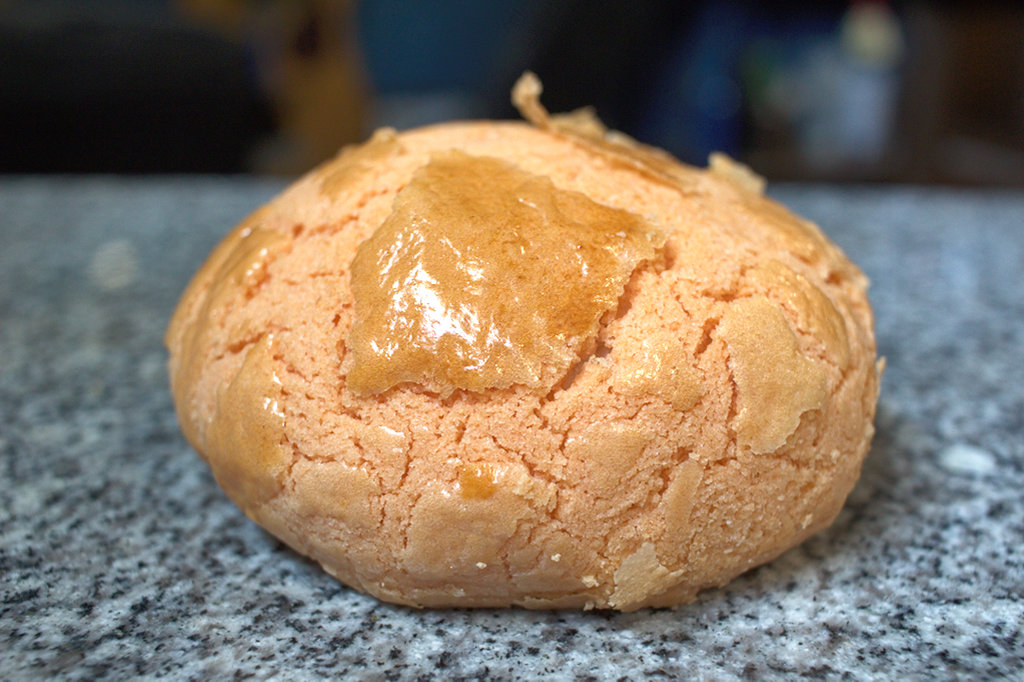
The Tasty Place pineapple bun was pinkish in color, and most of those they had available were stuffed with red bean paste. I ordered one with and one without. As with most of these buns, there was a nicely browned eggwash surface to the cookie shell that largely wore off by the time I got them home and took pictures of them.

Chiu Quon is now well settled into the newer location I’d speculated about 4 years ago, and is still putting out a very high quality product.

Their pineapple bun had the most recognizably yellow cookie shell, possibly from the addition of custard powder to the dough. As with others, much of the browned eggwash had flaked off in transit.
Continuing my planned circuit through Chinatown, I found Feida closed. St. Anna’s Bakery was closed. Though I found another bakery in Chinatown Square Mall, it was a Korean/French bakery and did not make pineapple buns. I did find another new-to-me Chinese bakery on Cermak, next door to Xi’an Cuisine and just a few doors down from “Little” Three Happiness, called Sunlight Cafe & Bakery.

There was a language barrier, and I was having problems communicating my request for pineapple buns, but a man rushed out of the kitchen in the back and shouted “bola bo! bola bo!” and saved the day.

Only 3 places in Chinatown that day were open and serving pineapple buns. Yet between these, the Korean/French bakery (Tous Les Jours), and a small market in the Chinatown Square Mall, I managed to bring home quite a feast, and nearly a dozen pineapple buns.

Sticky rice 
Durian wafers 
Noodles from Sunlight Cafe 
Kim Chi Croquette from Tous Les Jours 
Strawberry and cream croissant from Tous Les Jours
A delicious afternoon was had by all. Here’s the thing about those pineapple buns though. While I did prefer the Chiu Quon bun slightly they were all good, and very similar, despite the cosmetic differences. The bread bun was very soft and slightly sweet, while the cookie shell was crumbly and a little bit sweeter. None of them, on their own merits, would be considered a sandwich. But in Hong Kong, bolo bao is often sliced open and served with a thick slab of cold butter in the middle, becoming boh loh yao.

That’s it. That’s the sandwich. The end.
DIY Bolo Bao
But of course it wasn’t the end, because I can’t resist reading more about bready, sandwichy things, and I learned that not only do they add butter to these buns to make sandwiches in Hong Kong, but they often add egg or meat or other items. Now the Boh Loh Yau, that refers to the butter version–boh loh or bolo for pineapple, and yau or yao for oil/fat/butter. But there are other versions out there. Los Angeles has a restaurant called Bolo that serves a version stuffed with fried chicken. Happy Day Cafe in Vancouver fills their bolo bao a number of ways, with pork chop, BLT, and corned beef among their options.
So I baked some pineapple buns.

The recipe I used came from a site I haven’t visited before, called YI Reservation. It’s the recipe blog of an Asian man living in NYC, and his pineapple bun recipe worked out great for me.

I may have baked them just a touch harder than they would in Hong Kong, but I like the brown lacquered look of the egg wash and the contrast between it and the software cookie shell around it. I think these turned out great.

So many pineapple buns. How to use them all?
Spam Bolo Bao
Spam has made an appearance or two on these pages–most notably (I think) in the Elvis in Hawaii sandwich during my Month of Breakfast Sandwiches back in 2015. While it may seem like I regurgitate my every meal onto this blog I don’t believe I’ve mentioned my recent affinity for Spam Musubi, a Hawaiian sushi-like snack featuring Spam that is fried or grilled and lightly glazed with sweetened soy sauce. It is served cool or at room temperature on a pressed brick of sushi rice, wrapped in nori.
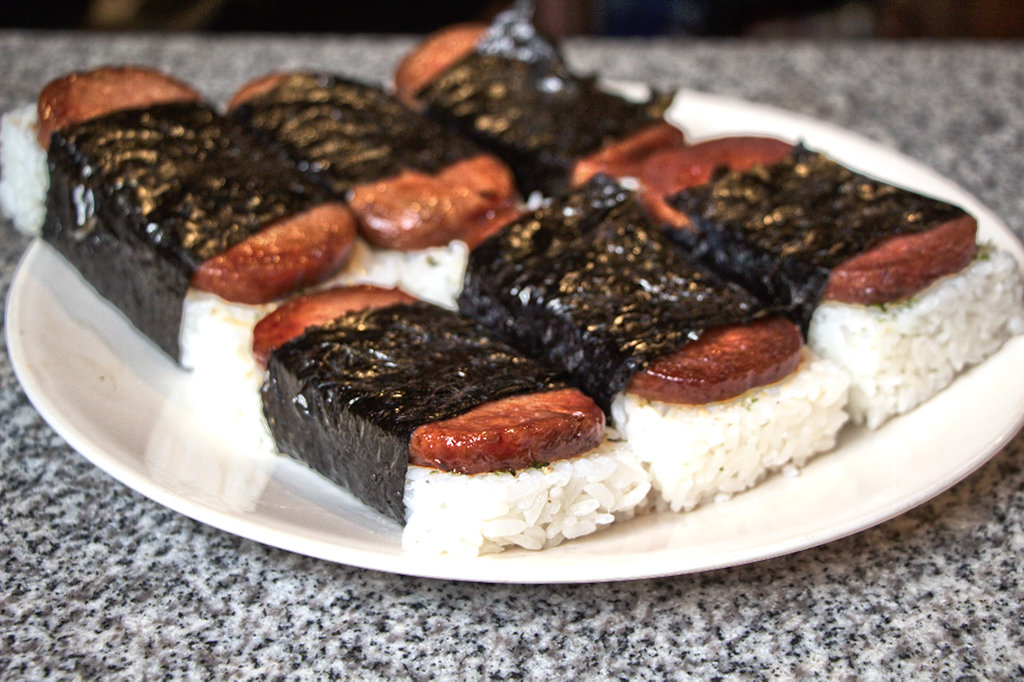
I can’t get enough of these things, and since I usually am able to make 8 of them from a single can of Spam, it was not a terrible loss to sacrifice two of the glazed slices of Spam to a pineapple bun to see how it turned out.

Spam is highly salty and fatty but soft-textured. Frying it or grilling it gives it a crisp exterior, but for the most part it is texturally soft while intensely flavored. It may not be for everyone. That combination though, along with the candied quality given it by the glaze, is part of what makes it work so well in musubi, where it is outmassed by the block of chewy but quite mild rice it sits atop, and must provide enough flavor for the whole.

The situation with the Spam pineapple bun is similar. The bun is soft and sweet and has a nice flavor of its own, but one that is greatly enhanced by the thin meaty layer of Spam. Between the juiciness of the Spam itself, the slight tackiness of the glaze, and the softness of the bun, no additional condiment is required. This is an outstanding use of the pineapple bun.
Ham and Egg Bolo Bao
That sweet/ham combination once again got me thinking about that trip to Chinatown back when Damian was just about to leave for college, a good memory, a sentimental one. It seemed like another good use of these bolo bao. So I picked up some thick slices of honey ham at the grocery store deli, and cooked myself a rectangular brick of egg in my seldom-used Japanese omelette pan.

This was a more savory, but less intensely salty, take on the pineapple bun that I appreciated. This would be a delicious breakfast option any time. The egg was seasoned with white pepper and just a pinch of MSG, soft with a rich mouthfeel and a touch of heat. The shaped ham had a more distinct and grained meatiness than the Spam, but was still moist and tender enough to easily bite through.

Another winner.
Char Siu Bolo Bao
Char siu is a type of sweet-glazed roast pork sometimes referred to on Chinese menus as BBQ pork. It’s made by marinading a piece of pork–belly if you want to get fancy, but more often than not something more prosaic like butt–overnight in a blend of sugar, five spice, Shaoxing wine, soy sauce, garlic, and other seasonings and then roasting it hard, glazing it toward the end of the cook to allow a caramelized surface.
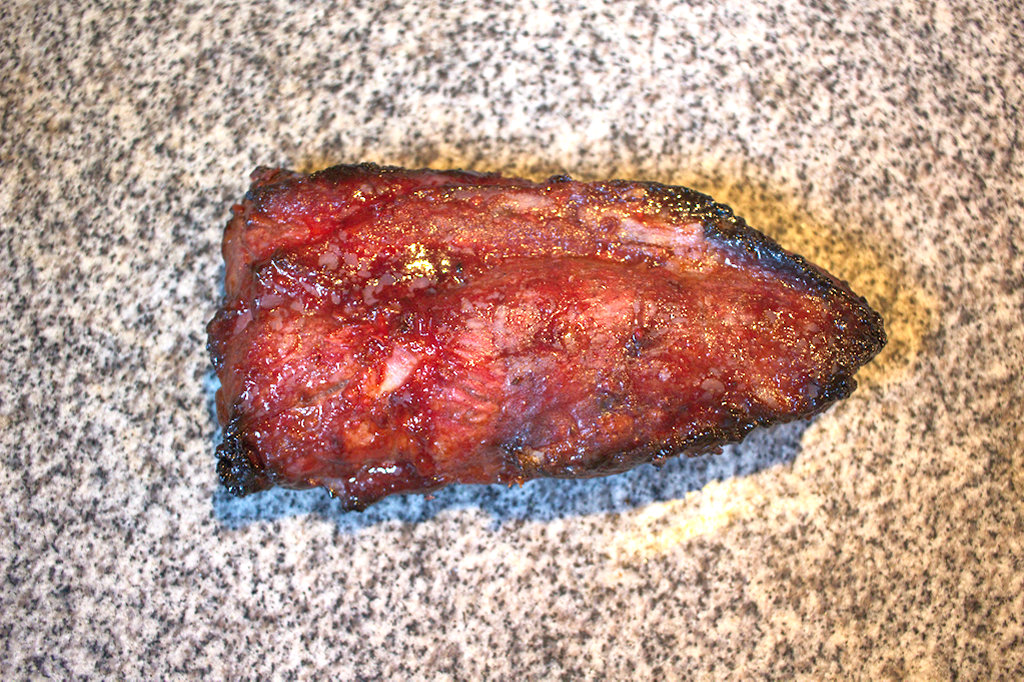
I made this char siu from a recipe on the site The Woks of Life. Though I’ve never made char siu before, the site’s recipes have served me well in the past, and I was pleased with how the char siu turned out, sweet, fragrant, crisp on the edges, chewy inside.

Again, this was a very good use of the pineapple bun, with the cooked and cooled pork moist enough that additional saucing was unnecessary. A little more of the char siu glaze wouldn’t have hurt anything, but it would have turned the balance of the sandwich sweeter than I generally like.
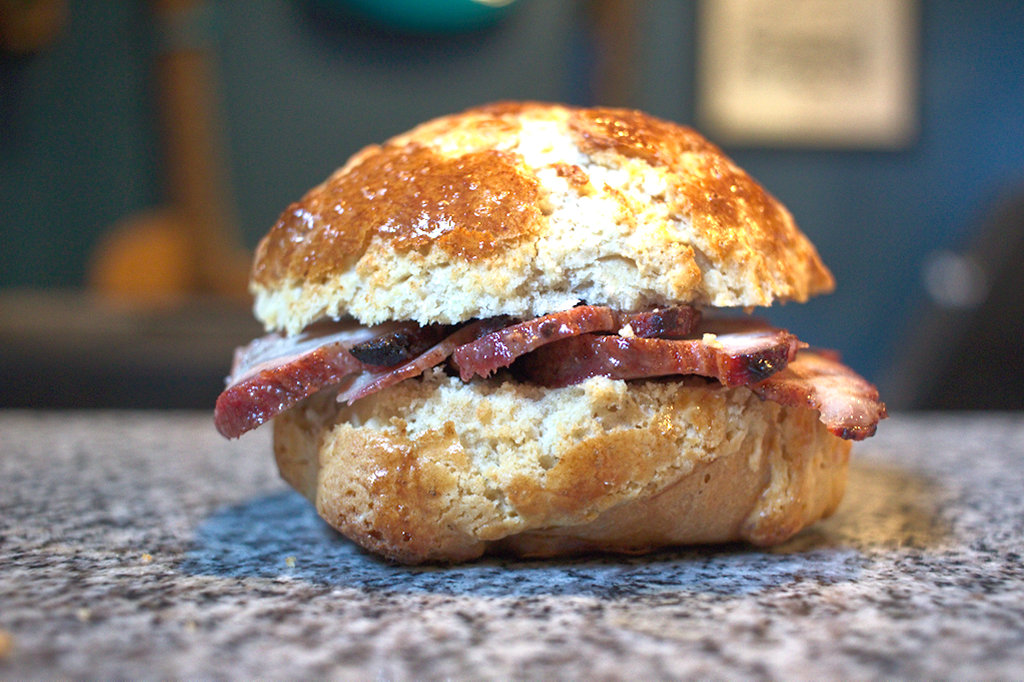
I may never make pineapple buns again, but I will be making this char siu pork again.
Beef Satay Bolo Bao
So far I’ve kept it pretty simple. “Where’s the fancy version?” you may be asking yourself. Anything worth doing is worth overdoing, after all. And yes, I have one for you. After all, I hate to disappoint. The idea for this sandwich came from the Happy Day Cafe menu I linked earlier. They listed a bolo bao stuffed with Thai beef satay.
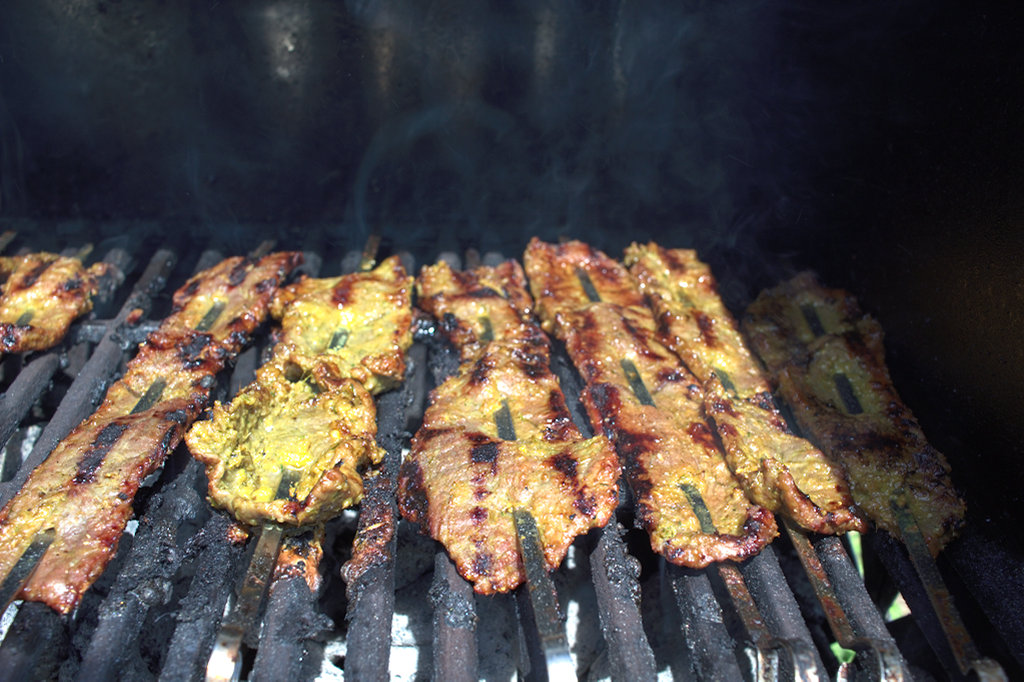
Beef satay consists of thin strips of beef, marinated in lemongrass, shallots, soy sauce, fish sauce, sugar, and spices, skewered and grilled, then served with peanut sauce on the side. It’s a tasty Indonesian appetizer often served at Thai restaurants. My recipes for both the beef satay and the peanut sauce came from the site The Spruce Eats.
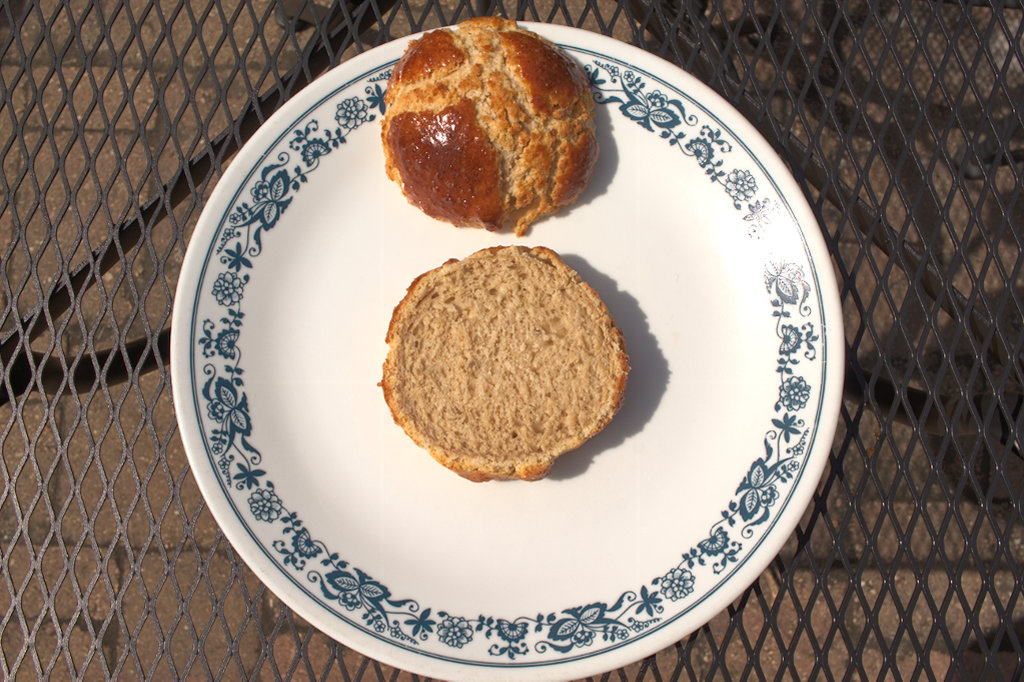
We start with the sliced-open pineapple bun, as I have not showed you the crumb yet. Note that it is browner than you’d expect a milk bread to be. Though I’m starting to see bread flour on the shelves at grocery stores again, I have been enjoying working with the locally-grown and -milled flours I’ve been buying from Janie’s Mill. This one is the Sifted Artisanal flour, which is lighter than the other flours I’ve used but still darker than most white bread flours. I think the buns turned out great regardless.
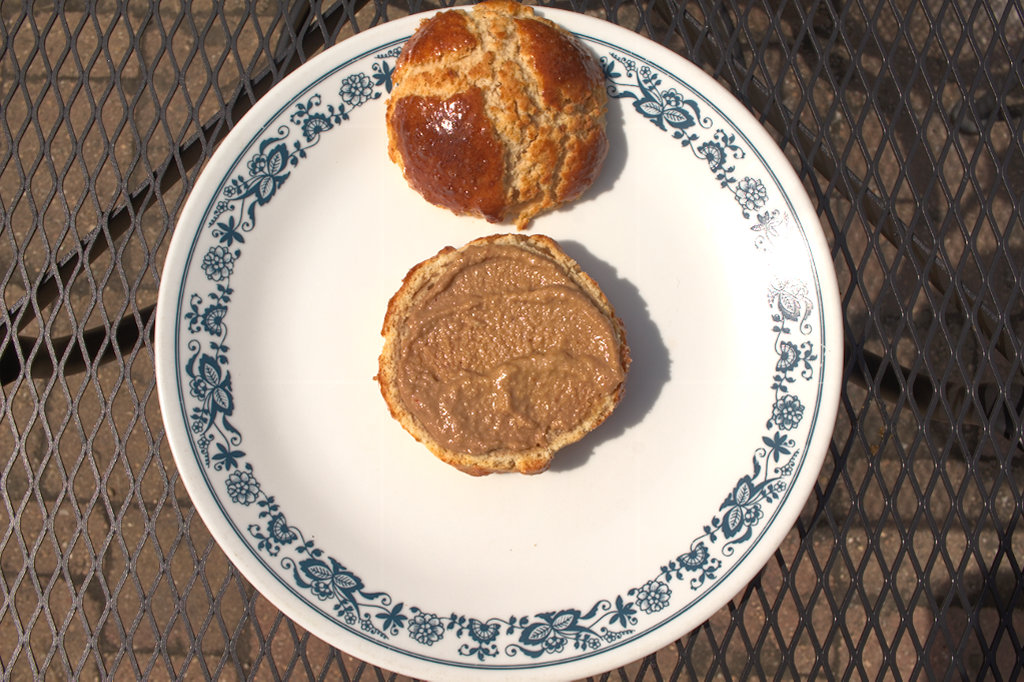
The peanut sauce, for the first couple hours after it’s made, has a garlicky kick that subsides once it’s had a little time to sit in the refrigerator. After that, well, nobody’s ever going to mistake it for peanut butter (at least not twice) but the flavors meld together fairly well, with the peanuts, fish sauce, and still a bit of garlic taking the lead. I made a double recipe of satay and only a single recipe of peanut sauce. The satay is long gone but I still have over a cup of peanut sauce left. If you have thoughts on how I can use it up, feel free to leave a comment below.
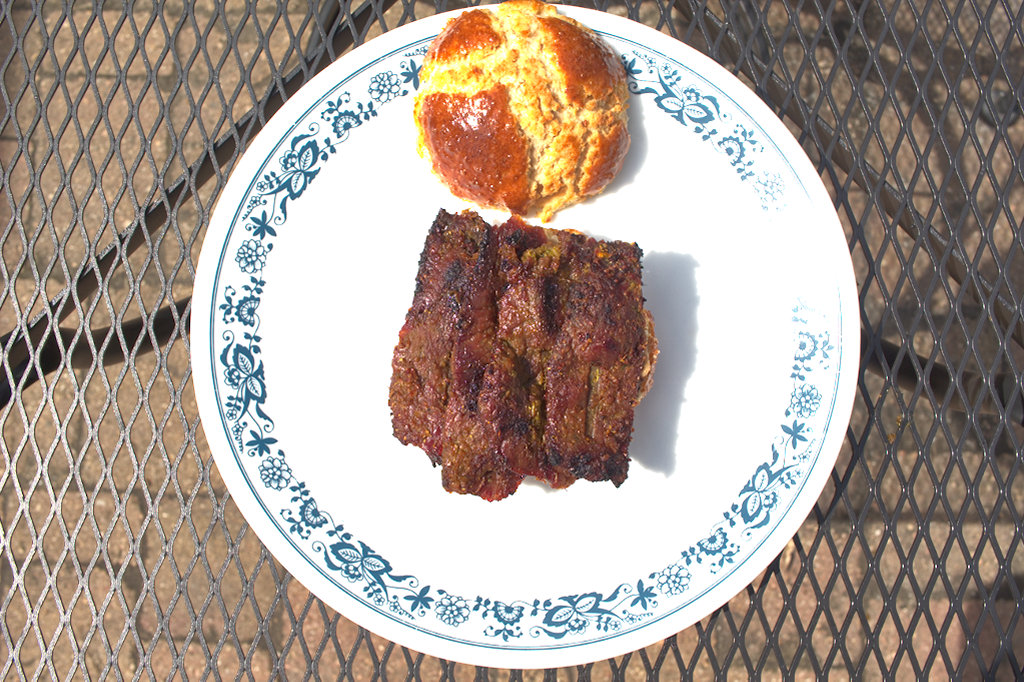
I used thin-sliced sirloin sip for the beef satay, and for the most part it held up well. My initial plans to grill this Friday evening were canceled by a rain that hit so fast and fierce that it darkened the sky and I had to waste already-burning charcoal since I could not even see the grill. The light was better Saturday afternoon for these photos anyway.
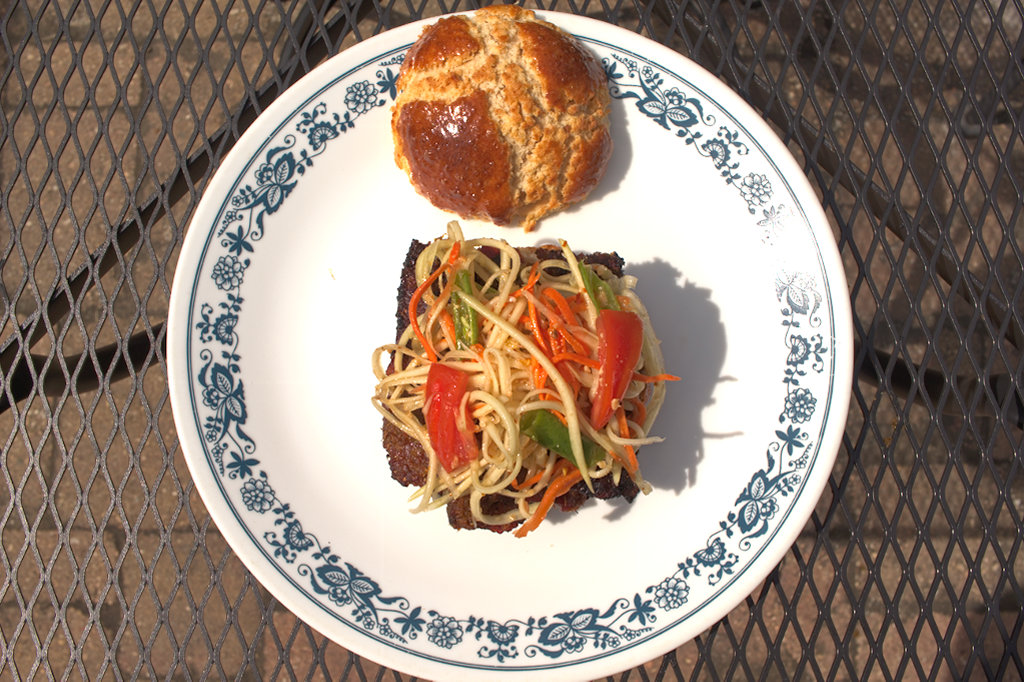
Calling a last-minute audible, we phoned in an order for green papaya salad to a nearby Thai restaurant and added it to the sandwich as well. As meat-and-fat heavy as all these bolo bao sandwiches had been, I wanted to add a light, bright component to this one.
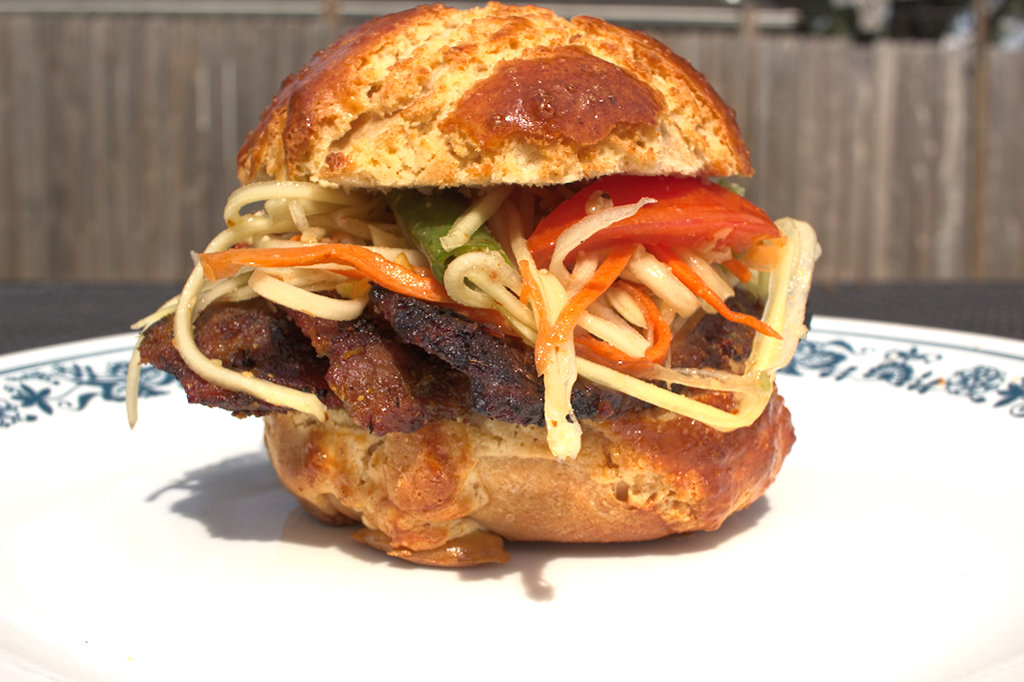
This was a great combination for a sandwich, but would have worked great together in any bread. What made it especially good in the pineapple bun was how the slight sweetness of the bun accentuated a similar sweetness present in every one of these components, and tied them together as a result. I’ve often said that a great sandwich begins not with a great bread, but with the right bread. In this case, the right bread came together with the right fillings and made something that transcended.
Boh Loh Yau
Of course, with all these various bolo bao sandwiches, we are gilding the lily. The pineapple bun is still amazing on its own, warm from the oven, filled with a simple slab of ice cold butter.
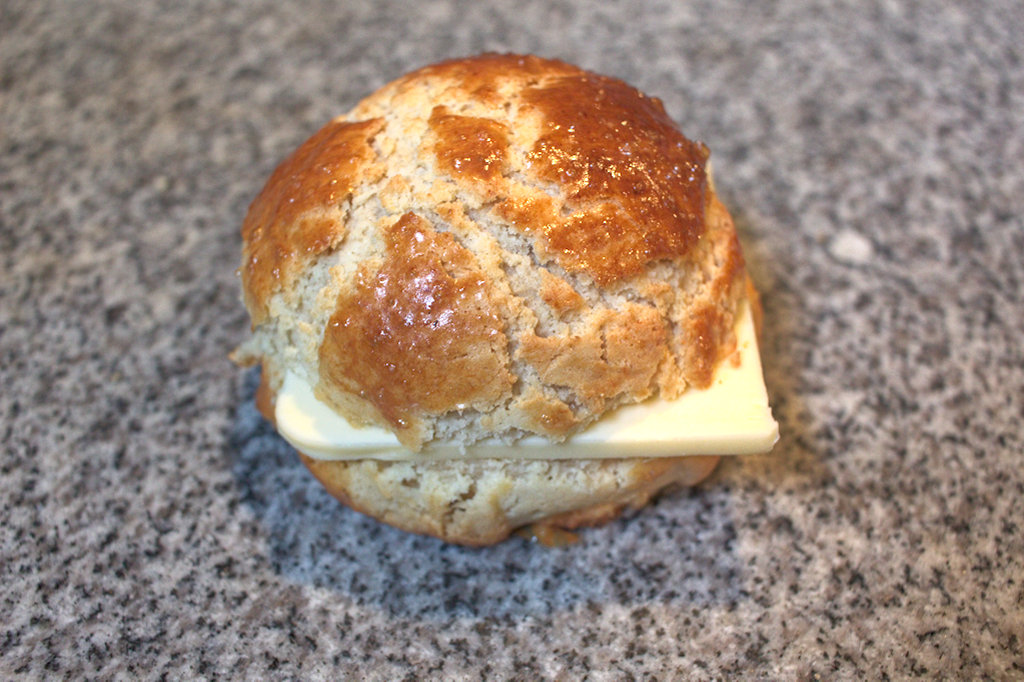
The butter must be cold, and sliced, not spread on the bread. The outer edges maintain their shape while the middle of the butter melts into the bread. The butter and bread both have textural gradients, from the crisper/firmer exterior to the softer/gooier interior. It’s a fine breakfast or a midafternoon snack, with a hot cup of tea or coffee.
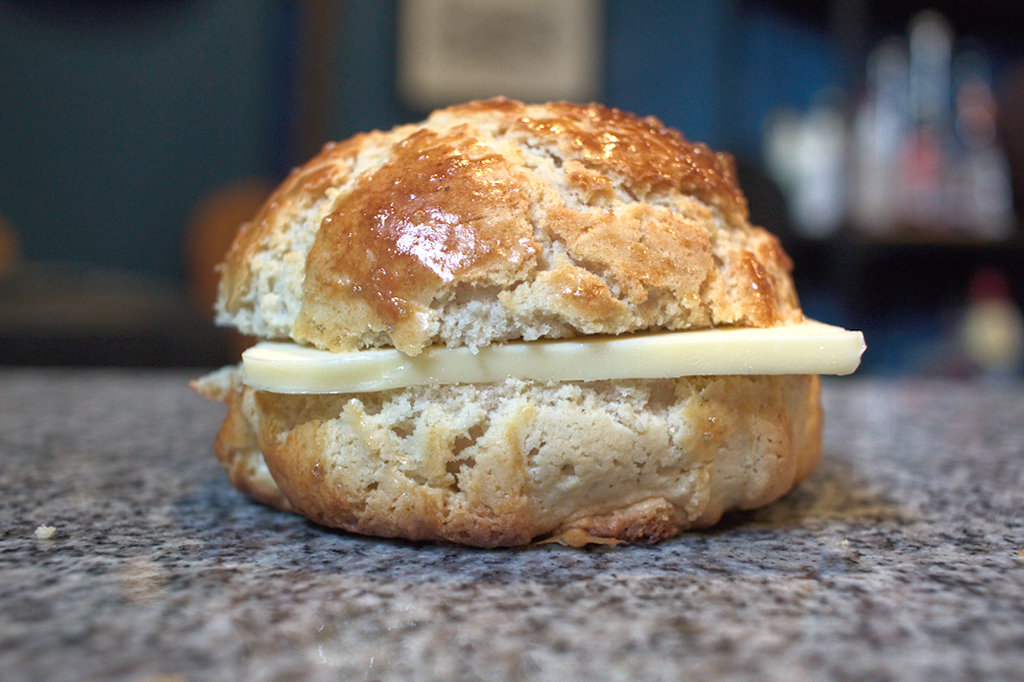
As far as I can tell, the bakeries in our Chinatown are not offering these as sandwiches yet, but it will be interesting to see if the versions offered in California and Western Canada spread eastward, as so often happens with Chinese food trends in America. Is there a place local to you making sandwiches with bolo bao? Please let us know in the comments!

I like sandwiches.
I like a lot of other things too but sandwiches are pretty great



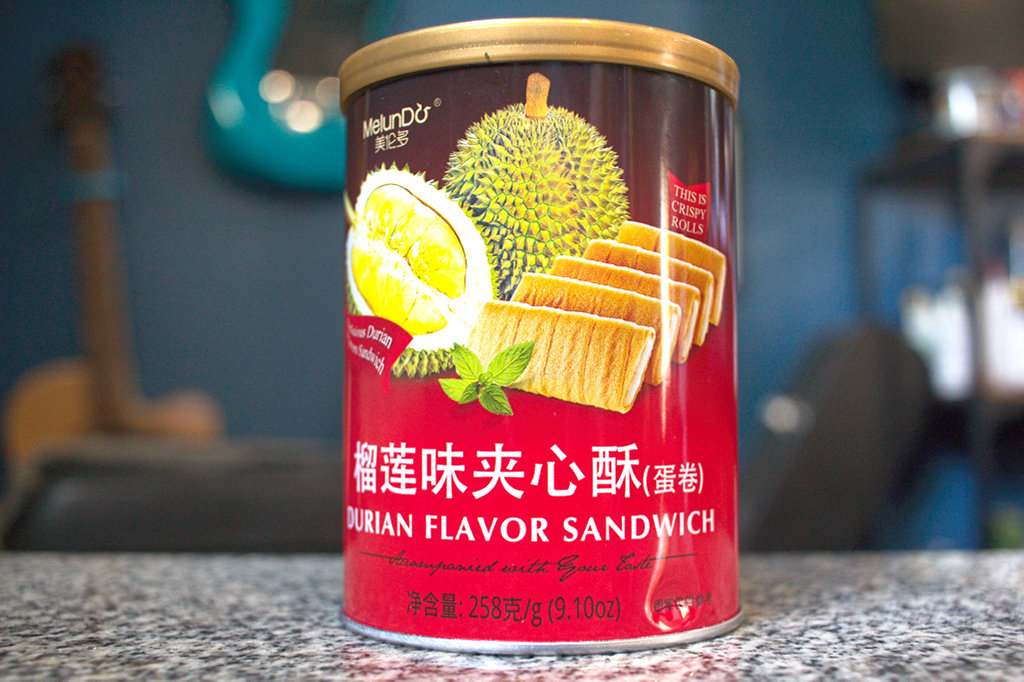


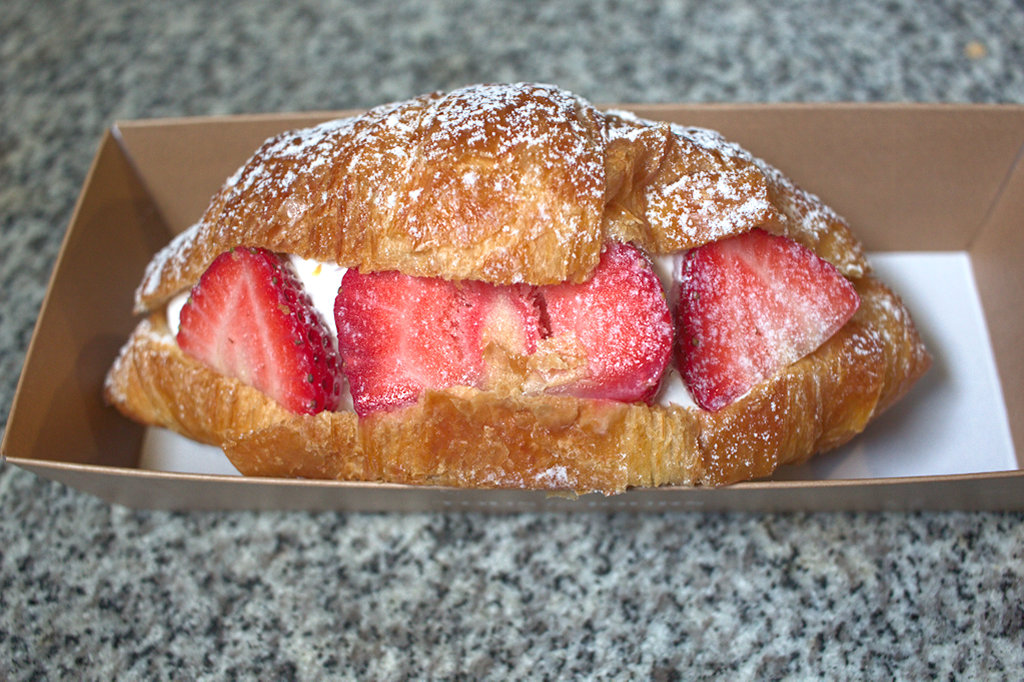



Although I’m a native Hong Konger, I don’t share the endless fascination for pineapple buns. Don’t get me wrong, I like them and I’ll eat them, but I don’t think they’re the bee’s knees like everyone else seems to. I prefer my butter on toast too. My cha chan teng (milk tea house – what we call bakeries that serve milk tea and coffee) poison is cocktail buns or “gai mei bao”, literally chicken tail buns. They’re longish and filled with some sort of sweet coconut filling, and they have two thin strips of the pineapple bun cookie shell on top. Yummy.
Oh right, a bun isn’t a sandwich. Forget I mentioned it then.